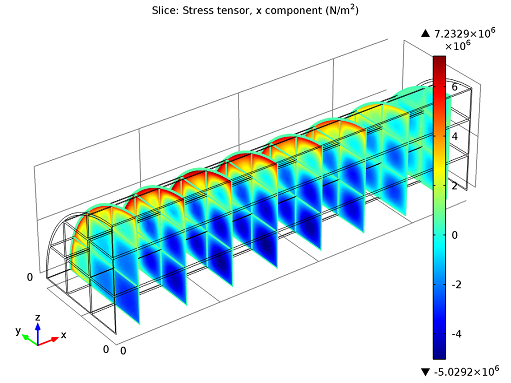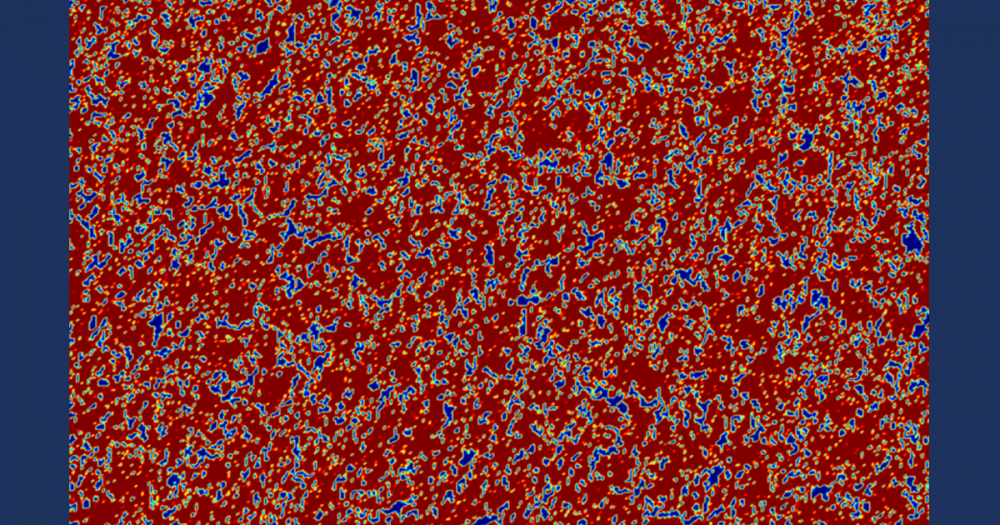
comsol的美丽是,无论您执行哪种类型的模拟,它都会提供一个统一的建模平台。这几乎是CAE市场独有的。最近,我们向您展示了如何使用单片反应器作为我们的示例对化学反应进行建模。首先,我们引导您解决反应动力学,然后涉及插头流,接下来我们创建了反应器的全尺度3D模型。化学工程师可能会使用针对此类仿真进行优化的软件感到舒适,但是如果他或她必须考虑设备或过程中的其他属性,该怎么办?例如,催化转化器是一个放热反应器,位于汽车或卡车的排气旁,可能需要在更换之前足够生存和功能多长时间。在“建模化学反应”博客系列的最后一部分中,我们将对转换器进行热应力分析。
3dModel of a Monolith Reactor Confirms Suggested Chemical Ratio
to recap what we did in the previous two blog posts, our reaction kinetics analysis and plug flow model suggested an NH3:没有1.3的比率,我们的整体反应器的完整3D模型证实了该比率。3D模型还允许我们了解该系统将如何全面运行,从而导致我们进行最终分析以进行:热应力。

选择性的模型在整体反应器中无降低。
Performing a Thermal Stress Analysis
We’ve already determined what ammonia dosage we need for our system and what the reactor should look like. Aswe noted before,整体反应器经历温度的持续变化。热量是由化学物质产生的,这些化学物质在整个系统中以不同程度的不同程度散入周围环境。这种温度通量以及不同的材料特性,结构由可以导致热应力组成。因此,为了真正优化反应堆的性能,我们需要分析热应力。
Let’s assume we have the 3D model we created in Part 2 of this series open in the化学反应工程模块。Before we can run our thermal stress analysis on the model, we need to extend it by coupling the temperature field to a structural mechanics analysis. The features and equations required for the stress analysis and general linear- and nonlinear solid mechanics are contained within the固体力学接口结构力学模块。these equations are the key to analyzing thermal expansion.
热负荷:
σ =dεEl+σ0=d(ε–εTh- ε0) +σ0
In this equation, σ is the stress,d是弹性矩阵,ε表示应变。
thermal strain:
εTh= α(t-t参考)
这里α是热膨胀系数,tis temperature (Kelvin), andt参考is the strain-free reference temperature (also Kelvin).
Results
Once we have solved for the physics and set up our model, it will look like this:

应力张量切片图。
在上图中,您可以在几个横截面中看到应力张量的X组件。您在通道块中看到的深蓝色,几乎向上沿通道上的一半表明了高负值或压缩应力。这也是拉伸应力(红色)最大的地方。因此,最大潜在故障的区域与温度场一致shown in our 3D model。
On the other hand, we have the outer regions of our channels, in particular towards the end of the converter. Here, not many reactions were occurring: the temperature was lower and there were far less stresses. In short, we can evaluate our maximum compressive stress to be about 5.0 MPa and tensile stress around 7.2 MPa. (During system start-up stress levels are expected to be more significant).
Conclusion and Next Steps
通过这种热应力分析,我们现在总结了我们的“建模化学反应”博客系列。我们已经分析动力学,创建了插头流模型,开发了一个全尺寸模型,甚至研究了影响系统性能的其他物理学。现在,我们知道需要什么氨剂量,系统的外观以及如何执行。下一步取决于您 - 也许您可以try modeling this multiphysics problem独自一人?





评论(0)